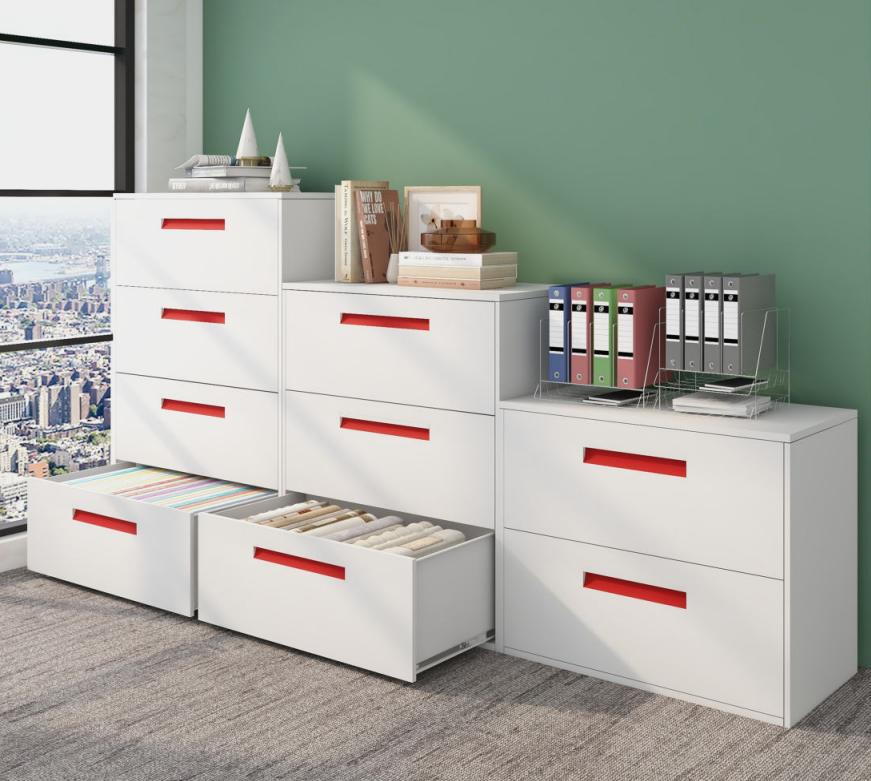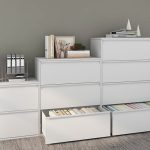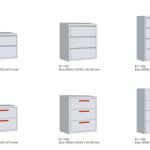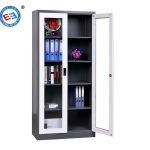Vertical and lateral file cabinets are two common steel file cabinets used mainly to store and organize files, materials, documents, and other items. These cabinets are widely used in offices, homes, schools, and various commercial and administrative environments. Both types of file cabinets have their advantages and disadvantages. Which type should you choose when purchasing? You can just read on to find out.
Vertical File Cabinet
What is a vertical file cabinet?
Vertical file cabinets usually feature a vertical structure, with multiple shelves or drawers designed to classify and store files, materials, and other office supplies. Offices, archives, and other environments that require large file storage typically use vertical file cabinets. These cabinets effectively save space while providing convenient access.

Advantages and disadvantages of vertical file cabinets
1. Advantages:
Provide security: Vertical file cabinets come with locks to protect files and materials, preventing unauthorized access.
Large-capacity storage: The cabinets offer ample storage space to accommodate numerous files, documents, and materials, allowing for easy classification and archiving.
Space saving: Vertical file cabinets take up minimal space and make full use of vertical space, making them ideal for places with limited room.
Strong combination: Vertical file cabinets can be combined to provide flexible storage solutions.
Strong and durable: Vertical file cabinets, made from cold-rolled steel, feature a strong load-bearing capacity and resistance to corrosion.
2. Disadvantages:
Inconvenient to move: Steel vertical file cabinets are heavy, making them inconvenient to move.
Limited storage: These cabinets are suitable for storing standard files or folders, but they are not ideal for larger files.
Lateral File Cabinet
What is a lateral file cabinet?
A lateral file cabinet features wide, horizontal drawers for organizing documents and files. These broad drawers allow for side-by-side storage, making it easier to access documents without excessive bending or reaching.

Advantages and disadvantages of lateral file cabinets
1. Advantages:
Easy to access files: Lateral file cabinets have wider drawers, allowing files to be stored side by side for easy access and filing.
Good stability: The relatively low center of gravity makes lateral file cabinets stable during use, reducing the risk of tipping or shaking.
Suitable for large-size files: Wider drawers can accommodate large-format files, such as A3 or A2 documents and engineering drawings, without needing to fold or compress them.
2. Disadvantages:
Large footprint: The design of lateral file cabinets requires more horizontal space, which takes up more room in offices or small work environments.
Higher price: Lateral file cabinets tend to have higher manufacturing costs and more complex designs, making them more expensive.
Small storage capacity: Since lateral file cabinets are usually shallower, they hold fewer files than vertical file cabinets.
The difference between vertical file cabinets and lateral file cabinets
Both vertical and lateral file cabinets have their advantages. The key differences between the two are summarized below:
| Consideration | Vertical File Cabinet | Lateral File Cabinet |
| Space Layout | Suitable for high spaces, better vertical utilization | Suitable for wide spaces, better for low spaces |
| Storage Needs | Ideal for storing a large number of small, categorized files or documents | Ideal for storing larger documents or frequently accessed files |
| Frequency of Access | For documents that are not accessed frequently | For documents that are accessed frequently |
| Appearance & Neatness | Compact, simple, takes up less horizontal space | Spacious, but may appear bulkier and requires better organization |
| File Type | Suitable for standard A4-sized documents and small files | Suitable for larger files, such as A3 documents, blueprints, and design plans |
| Storage Capacity | Larger storage capacity, ideal for storing many files | Smaller storage capacity, ideal for fewer files |
| Budget & Cost | More economical, suitable for environments with a limited budget | Relatively more expensive, suitable for environments with a larger budget |
Comprehensive comparison
Space requirements: If the office environment has limited space, especially vertical space, lateral file cabinets may be more suitable. However, if storage space is abundant or needs to be maximized, vertical file cabinets are a better choice.
Number and type of files: Vertical file cabinets are more effective for managing a large number of files of various types. Lateral file cabinets, however, work better for a smaller number of specific file types.
Security and privacy: Vertical file cabinets often feature locks, making them ideal for storing confidential or protected files. Lateral file cabinets are more suited for files that require frequent consultation or display.
Conclusion
The decision between vertical and lateral file cabinets depends on your specific needs and office space constraints. The best file cabinet is the one that integrates smoothly into your workspace and enhances productivity.





